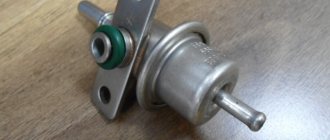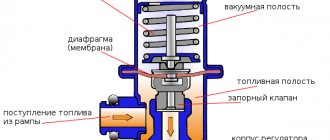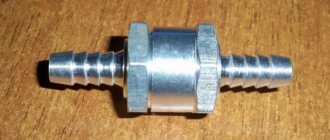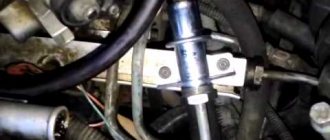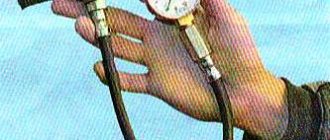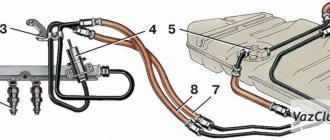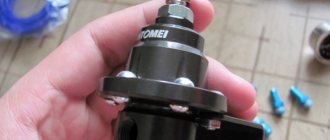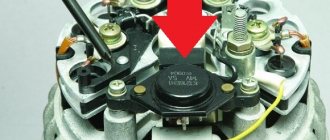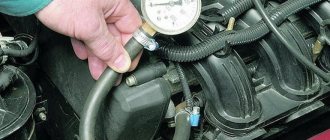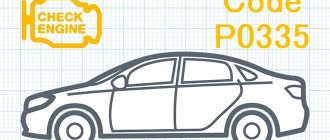All engines with an electronic fuel injection system are equipped with devices that maintain the required fuel pressure in the fuel line. In the VAZ-2114 power unit, this function is performed by a special regulator. It is thanks to this that gasoline is supplied under pressure to the injectors in the required quantity, depending on the operating mode of the engine.
In this article we will talk about what the VAZ-2114 fuel pressure regulator is, how it works and where it is located. In addition, we will consider its possible malfunctions and methods for eliminating them.
Design features and principle of operation
Structurally, the VAZ-2114 fuel pressure regulator is a membrane bypass valve enclosed in a metal casing. It is mounted on the ramp and inserted into it with one of the pipes through a rubber seal. The other output of the RTD is connected to the fuel line. To determine the load on the engine, the regulator is connected to the intake manifold with a vacuum hose. Thus, on the one hand, the membrane is acted upon by fuel supplied under pressure from the fuel pump, and on the other, by air pressure and the force of the valve spring.
The VAZ-2114 fuel pressure regulator has a fairly simple operating principle. When you press the accelerator pedal, excess pressure is created in the intake manifold, which opens the valve slightly, allowing more fuel into the ramp. When the throttle valve is closed, the air pressure in the intake pipe weakens. The valve opens in the other direction, releasing gasoline back into the fuel line.
Symptoms of RTD malfunction
A faulty VAZ-2114 fuel pressure regulator does not pose a critical threat, but its failure disrupts the stable operation of the engine. Symptoms of RTD failure may include:
- difficult starting of the power unit;
- unstable crankshaft speed at idle;
- reduction in engine power characteristics;
- loss of dynamics;
- the occurrence of “dips” when pressing the accelerator pedal;
- increase in fuel consumption.
Having discovered the listed signs of an RTD malfunction, you should diagnose the device and determine the cause of the failure.
Device
The regulator includes two cavities - fuel and vacuum. Inside the vacuum there is a membrane that reacts to the air pressure coming from the power unit. Inside the fuel cavity there is fuel under high pressure.
Scheme
The force of fuel pressure is resisted by a valve device. If the pressure is excessively high, the excess is returned back through the relief means.
Possible malfunctions of the RTD
Considering that the design of the pressure regulator is mechanical, malfunctions in its operation can occur quite often. The most common device malfunctions include:
- weakening of the membrane spring;
- valve jamming;
- regulator clogging;
- violation of the tightness of the junction of the regulator and the ramp body.
When the diaphragm spring weakens, the valve cannot cope with the air pressure coming from the intake manifold. As a result, the pressure and amount of incoming fuel are reduced.
Valve jamming leads to an uncontrolled supply of fuel to the manifold and its “waste” into the fuel line. In this case, gasoline consumption increases, and the engine stops starting normally due to interruptions in the fuel supply.
Similar signs of malfunction can be observed when the regulator is clogged. Dirt and deposits reduce the throughput of the system, as a result of which the fuel pressure decreases significantly, the engine “chokes”, and normal idle speed disappears.
If the seal between the regulator and the ramp is broken, the air pressure may drop, which again will lead to a decrease in fuel pressure.
Fuel pressure regulator VAZ 2110 - check and replacement
Fuel pressure is one of the most important indicators used in diagnosing the operation of a car engine. The efficiency and usefulness of all parts that make up the fuel system depend on it. That is why it is necessary to maintain the correct pressure, regardless of the functioning of the engine. This task is precisely performed by the RTD in the VAZ 2110. Every motorist must remember that it is the pressure regulator that affects gasoline consumption and engine power. A faulty regulator will not allow the engine to operate normally and should be replaced.
From this article you will learn what signs of problems with the RTD are most often found in the VAZ 2110, as well as how it is possible to independently check the regulator and replace it.
What you need to check the pressure in the system
In order to verify the serviceability (malfunction) of the RTD, as well as the entire fuel system, it is necessary to determine the value of the fuel pressure. Naturally, you will need a special tool for this.
It's called a fuel pressure gauge. It is better if it has a mechanical design and a scale of up to 10 kg/cm2. In addition to the fuel pressure gauge, you will need:
- a piece of high pressure hose (internal diameter 8-10 mm);
- several clamps corresponding to the diameter of the hose;
- pliers;
- screwdriver;
- nipple cap;
- fuel collection container;
- dry clean rag.
Pressure measurement modes
Before checking the pressure in the fuel rail, it is a good idea to find out how this process is carried out. To be able to more accurately determine a possible malfunction, pressure measurements must be carried out in several modes:
- with the ignition on (without starting the power unit);
- with the engine running at idle speed;
- with the vacuum hose disconnected from the regulator (to check the operation of the RTD);
- with a blocked fuel return hose;
- in overdrive mode.
How to check fuel rail pressure
The procedure for taking pressure measurements is as follows. First, connect a fuel pressure gauge to one end of the hose and secure the connection with a clamp. We unscrew the cap on the fuel rail (on the side opposite to the one where the RTD is installed). We place a container under the fitting to collect fuel. Using the nipple cap, press the central protrusion, thus releasing the fuel pressure in the system. This process is required! Next, without removing the container, unscrew the locking nipple completely.
When the remaining fuel has drained into the container, put the other end of the hose on the fitting and secure it with a clamp. Turn on the ignition and wait until the gas pump pumps fuel into the system. We check the pressure and compare it with the recommended one.
After this, we start the engine and take measurements at idle. Checking the functionality of the fuel pressure regulator is carried out with the vacuum hose disconnected from it and with the power unit running. If the pressure has increased to 3.3 kg/cm2, the regulator can be considered operational. If it has not changed, the RTD has most likely become unusable.
Similarly, we measure pressure when the return hose is closed, as well as in the gas overflow mode.
Examination
If you find characteristic symptoms, first we recommend that you make sure that the problem with the car is related specifically to this sensor.
The inspection is carried out as follows:
- At the end of the ramp block there is a fitting designed to check the pressure indicator;
- It is covered with a plug that you need to unscrew;
- At the bottom of this plug there is a ring that compensates for the distance;
- If there are signs of damage or defects on the ring, be sure to replace it with a new one;
- Now take the cap from the tire and unscrew the spool with its back. It is located in the middle of the fitting;
- Now a flexible hose from the measuring device is connected to the fitting. You can use a regular pressure gauge that you use when inflating tires;
- Clamp the hose with a clamp and start checking;
- Turn on idle, since this is where the vacuum is the lowest and the fuel pressure is the highest;
- Start the engine. The device should show 2.9-3.3 units;
- Now check the readings, only without the vacuum hose;
- Having removed it, the pressure gauge should give about 0.2-0.8 units. If no changes occur, then the regulator is definitely out of order and needs to be replaced.
Replacing the RTD
The RTD can be replaced either with the fuel rail removed or without dismantling it. The latter option is more preferable as it requires less time. But before removing the fuel rail or the regulator itself, do not forget to reduce the pressure in the system as described above! Otherwise, the entire engine compartment will be splashed with gasoline.
So, let's look at how to replace the VAZ-2114 fuel pressure regulator without dismantling the ramp. For this you will need:
- key to “10”;
- key to "17";
- key to “24”;
- hexagon to “5”;
- screwdriver with Phillips bit;
- clean dry cloth.
Work order
- First, disconnect the negative terminal from the battery (key to “10”).
- Disconnect the regulator vacuum hose from the intake manifold fitting.
- Using a “17” wrench, unscrew the nut securing the drain hose. Disconnect the hose.
- Using a Phillips screwdriver, unscrew the bolt of the return pipeline clamping plate.
- Using a hex wrench set to “5”, unscrew the screws securing the RTD to the fuel rail.
- Using a “24” wrench, unscrew the nut connecting the drain hose fitting and the RTD.
- Remove the fuel pressure regulator.
That's basically the whole process. Installation of the RTD is carried out in the reverse order. Important: do not lose the rubber seal that comes with the regulator. Without it, the connection between the RTD and the fuel rail will be leaky, which will lead to a change in the operating pressure in the system.
fuel pump
The fuel pump supplies fuel to the injection system and maintains operating pressure in the fuel system. The fuel pump can be electrically driven or mechanically driven. The mechanical drive of fuel pumps is outdated and was used on engines equipped with a carburetor. Modern fuel injection engines use electric fuel pumps. All electric pumps are a cylindrical housing that contains: an electric motor, a pump section, ball check and safety valves and, as a rule, a strainer. Electric fuel pumps are divided into submersible (installed in the gas tank) and mounted (installed outside). Suspended type electric fuel pump:
1 - discharge pipe, 2 - check valve, 3 - housing, 4 - strainer, 5 - suction pipe, 6 - terminals, 7 - manifold, 8 - electric motor, 9 - pump section, 10 - safety valve.
Suspended electric fuel pumps are mounted under the body or in the lower part of the engine compartment, as a rule, so that gasoline can flow into them by gravity. Suspended pumps are sealed.
Submersible electric fuel pump:
a - fuel intake with pump; b - appearance of the pump.
The submersible ones are located inside the gas tank and are built into the fuel intake.
Some useful tips
To ensure that the fuel pressure regulator does not cause you trouble and works as long as possible, use these tips.
- When planning to replace an RTD, buy only a branded device recommended by the manufacturer.
- Fill your car tank with only high-quality fuel. Do not use fuel additives of unknown origin.
- Do not forget to promptly replace the fuel filter.
- At each maintenance check the fuel pressure in the system. If problems are identified, correct them promptly.
- If you find problems with the regulator, do not delay replacing it.
What determines the price of a part?
Buying a fuel pressure regulator for a VAZ 2114 can cost varying amounts of money. When determining the price, sellers take into account the following factors:
- Originality of the valve.
- Part condition.
- Reputation of the manufacturer.
- Spare part quality.
- Availability of guarantee.
- Presence of manufacturing defects.
- Level of competition and prices in other companies.
- The need to deliver goods.
Today, in times of high competition, most stores adhere to a flexible pricing policy. Therefore, companies often organize sales and promotions and give good discounts. Some stores have a loyalty program for regular customers. Many retailers offer to use discount coupons and promotional codes when placing an order.
